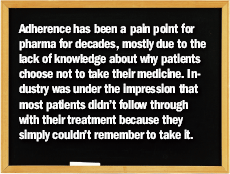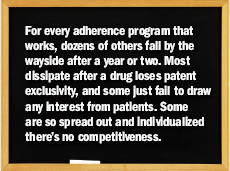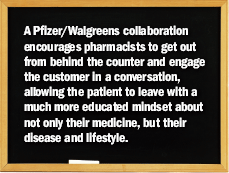Adherence Through Education
Pharma's quest for patient adherence has been trying. Could better patient education be the answer?
There is no question that a large number of patients do not adhere to their treatment regimens. Whether they ignore their doctor's orders and don't fill their prescriptions, refuse to pick up prescription orders at the pharmacy, or just don't continue on their medication, the fact is nonadherence is a huge problem for the pharmaceutical industry and all parties with ties to the healthcare system.

GETTY IMAGES / PURESTOCK
"People always said that medication nonadherence was a $100 billion weight on our healthcare system," explains Elizabeth Oyekan, area pharmacy director for the Kaiser South Bay Medical Center. "But as of five years ago, that number literally tripled, and in the literature you'll see that it is anywhere from $177 billion to about $300 billion."
The problem is so deep that all stakeholders in the healthcare industry are struggling to figure out what to do. Pharma companies are hindered, because patients feel their adherence programs are too promotional; physicians complain that they don't have enough time to meet with patients, let alone sign them up for compliance programs; and payers are frustrated because patients that start and stop medications are likely to cost more in the long run, especially if their non-compliance puts them in the emergency room.
Making Sense of Adherence
To be fair this isn't a new problem. Adherence has been a pain point for the pharmaceutical industry for decades, mostly due to the lack of knowledge about why patients choose not to take their medicine. Industry was under the impression that most patients didn't follow through with the their treatment because they simply couldn't remember to take it.
The US Outcomes Research Group at Merck wanted to test this theory and analyzed 79 studies pertaining to the reporting of prescription nonfulfillment rates at the patient and prescription level.

The report, "Medication Nonfulfillment Rates and Reasons: Narrative Systematic Review," categorizes medication nonadherence into four categories:
»Primary Nonadherence—Patient never fills the first prescription.
» Early Nonpersistence» Patient doesn't refill the medication after the first prescription.
» Secondary Nonadherence» Patient does not take his or her medication as prescribed.
» Secondary Nonpersistence» Failure to continue treatment after first prescription is filled.
After reviewing nearly 30 years of research, it was determined that 15 percent to 20 percent of patients, on average, do not get their first prescription filled.
According to Abhijit Gadkari, senior manager, Outcomes Research at Merck, the old adage that patients just can't remember to take their medicine proved to be a myth. Instead, the main reasons for nonadherence are:
» Concerns about the medication;
» Lack of perceived need for the treatment; and
» Affordability.
The report states that "about one-third of chronically ill adults who underuse prescription medications because of cost do not discuss medication affordability with their providers in advance, and may never raise this issue with their providers at all."
However, the fears about taking a medication or the feelings that a drug isn't needed fall squarely with the physician. The report cited a 19 percent spike in risk of nonadherence in patients that felt they didn't understand what their physician was telling them. This is a particular headache for the physician, because he or she typically isn't reimbursed for time spent educating patients about their treatment. Add to that the short amount of time a doctor has to see the patient and it is possible that many patients feel overwhelmed and underserved after receiving a prescription.
Worst yet, new technology such as e-prescribing might make things worse. Merck found that in the few studies that had e-prescribing, if the patient hadn't walked out with the physical copy of the prescription in hand, sometimes they didn't realize that the scrip was written and might not come back to fill it. Either they forgot that the scrip was directly sent to the pharmacy, or they might not know that it was written at all.
"If the patient doesn't come in for that first scrip—if they don't have a chance to see if the drug works for them or not—there's really no chance that the patients can experience firsthand if the therapy is working for them," explains Gadkari. "In that case, the pharma industry is losing these patients forever."
The situation is a giant catch-22 that won't be rectified until some kind of paradigm shift happens that makes all of the stakeholders responsible for the success of treatment regimens.
The closest thing down the pike is pay-for-performance (PFP), a controversial initiative in which insurance companies will compensate physicians based on the outcome of the patient. Physicians are incentivized to make sure that a patient stays on a treatment path and follows the regimen prescribed. Pilot programs for PFP are under way, but how well they will work is still undetermined.
"With the focus on outcomes, we can't just look at efficacy and know that this drug lowers cholesterol," says Jonothan Tierce, general manager, Health Economics & Outcomes Research, IMS Health. "We realize that we are all in the same situation—the payers, the providers, the patients, and the physicians—and we all have a common interest in getting patients to take their medication so that we can get the outcomes that we are looking for."
Research shows that if pharma companies send out reminder letters, a few more patients will take their medication more regularly, but it's not a big proportion of patients. The goal then is to target patients based on the exact reason why they rejected the drug.
"The key is understanding why somebody doesn't come in to take medications and then implementing interventions or messages that are tailored to patient's specific beliefs," explains Gadkari.
Framework for Success
The buzzwords "targeted education" are reverberating throughout the healthcare industry as the best way to help patients stay on their treatment. Kaiser Permanente, the biggest payer in California, recently received an innovation grant to create a framework to systematically address nonadherence to avoid the trial-and-error methods that most pharma companies are implementing.
"They said, 'Okay, we will give you some money,'" Oyekan says. "'Go work with a team of people to come up with the tools to put this concept into reality.' And so we went to work with that."
The Kaiser team created tools centered on a handbook titled "Be Smart" that was initially released for pharmacists and nurse care managers. The book outlines the different types of barriers and how to assess whether or not a patient is even willing to address these barriers, the different barriers, solutions, and the different resources within and outside of Kaiser Permanente.
"The next chapter deals with how to motivate a patient," Oyekan continues. "Here, we started talking about how companies must look at a patient who is on medications—like a marathon runner. You just don't go out there one day and say, 'I'm running a marathon' and you're successful at it."
The handbook outlines a litany of tools that can be used to get patients invested into their treatment, including: regular e-mails, snail mailers, regular phone calls, meetings with care managers, and informational classes.
A big part of the program is also about understanding adherence around a particular treatment. Kaiser groups the different medications it dispenses in the outpatient pharmacies by drug class, and then lists key topics associated with the treatments that pharmacists can talk about with patients.
"So we can actually identify the patients who are nonadherent," Oyekan says. "We can give those patients to the provider, and then the provider can use the 'Be Smart' methodology to identify what the issue is with the patient, give the solution, and then triage them either to health education, to a care manager, to a pharmacist, and to the different other resources that are available to the patient."
The big question that remains is how can a program like this be tailored to the individual patient? Much of the handbook includes no-nonsense ways to proactively educate and inform, but shouldn't much of the conversation be common sense at this point?
According to IMS Health, there is no easy—or low-cost—solution.
IMS Health studied the results of 755 adherence programs (from 1972 to 2002) pertaining to cardiovascular medications—a disease area that has a very poor level of compliance.

The study agreed with most of Kaiser's assumptions. "We found that the most effective approaches for improving adherence are multifaceted," the authors stated. "Personalized, intensive interventions offered the greatest improvements in adherence, as was found in our earlier study. However, these improvements in adherence with personalized intensive interventions must be balanced against their higher costs."
And the clincher here is higher cost. A traditional pharmacist program where the patient has a one-on-one session to discuss his or her treatment can cost upwards of $125 per patient. Compared to mailers that are sent out at random to everyone for the cost of a postage stamp and a postcard, the cost is astronomical.
"By targeting intervention, pharma companies are making the programs more effective and less expensive, because they aren't spending money on a lot of different tools to everyone," says Richard Chapman, principal, Health Economics & Outcomes Research, IMS Health. "Much like personalized medicine, if we can really hone in on a subset of patients that are really going to benefit from the different things, we can be much more effective in how we go after patients."
Pharmacist Involvement
One partnership that appears to be working well is the collaboration between Pfizer and Walgreens. The two giants in their respective industries created an informational program that allows the pharmacist to engage customers about their medication.
"We all know that the pharmacist can and should be playing a greater role in the whole healthcare system," says Adele Gulfo, US president and general manager, primary care at Pfizer. "The pharmacist is an educated person at the point of [dispension]—that's a very impactful point for a patient."
Pfizer and Walgreens launched an intervention-based program featuring behavioral counseling and education at the point where a patient goes to pick up his or her medication.
"When you have motivated participants, pharmacists are going to go out of their way to ensure that the patient understands their medicine and disease, and a more educated patient has a better shot at having a better outcome," Gulfo says.
This particular pilot program is only for Pfizer medicines, but the pharma giant would like to see it spread to other disease states.
"When you ask a patient, 'Why didn't you take that medicine?' by and large they will say that the physician didn't take the time to explain what the medicine really does," Gulfo says. "The second missed opportunity comes when the pharmacist doesn't explain it. That's where you get a lazy attitude on the part of the patient."
The Pfizer/Walgreens collaboration encourages the pharmacist to get out from behind the counter and engage the customer in a conversation, allowing the patient to leave with a much more educated mindset about not only their medicine, but their disease and lifestyle.
"We are not going to crack the code to adherence doing one intervention," Gulfo says. "Most times it's going to be multifactorial. The most opportune time where we've seen increased adherence rates is if you educate and get that patient engaged at the start of their medication program."
Getting Adherence On Track
While many critics have frowned upon pharma-driven adherence programs, the drug industry is not about to give up, and some programs are even achieving accolades.
Case in point: The Fosrenol "On Track" program by Shire, which was established as an addition to an existing patient assistance program to reach patients with kidney disease that are taking the medication to decrease blood levels of phosphate. Fosrenol is a phosphate binder that binds with phosphorus and removes it from the gastrointestinal track before it has a chance to be absorbed into the circulatory system.
The disease has numerous adherence challenges to overcome, most obvious of which is pill burden. Within the first four months of therapy, the average phosphate binder loses about 80 percent of prescriptions written—which is a significant dropoff over that timeframe. Another problem is that patients can't normally tell when their phosphorus is high (because they don't feel anything), yet pills must be taken after every meal. The average dialysis patient is on approximately a dozen different medications, meaning that cost issues must be taken into account.

"You're going in and getting 12 individual prescriptions filled with 12 different co-pays—that adds up pretty quick, regardless of if you are a commercial patient, a Part D patient, let alone a dual-eligible patient," says Tim Cox, senior product manager for Fosrenol.
The program launched in mid-2008 and has been lauded for successfully getting patients to stay on their treatment regimen. "On Track" includes a co-pay card, a patient assistance program, and relationships with third-party grant organizations to help patients that are Medicare Part D beneficiaries.
"Education is a critical portion in this disease state," explains Cox. "It's a matrix of individuals treating the patient. You have social workers, renal care techs, renal dieticians—there are a number of different folks that are influencing the patient and helping them better understand the disease state, the medication they are taking, and dialysis itself."

ADELE GULFO, US President, General Manager, Primary Care, PfizerThe second component of "On Track" is an opt-in adherence program for patients that helps renal nurses communicate with patients from a call center set up by a third party. There is also a series of five mailers that include details on food choices, information on how to better utilize support staff to get dialysis, and how to better interact with healthcare professionals.
Cox says that Shire tracks the program by tallying the number of drugs sent out through the patient assistance program, as well as through prescription-level data analyzed through data collection firms, such as IMS Health.

TIM COX, Senior Product Manager, Fosrenol, Shire"When we assess our programs, we look closely at co-pay card redemptions as they are used throughout a 12-year period," says Tanya Kuzminsky, renal dietician. "We've seen uplift in patients remaining on therapy by patients using that card. Similarly, when you look at the Fosrenol adherence program, we've seen a higher lift in persistency than even the co-pay program."
The program provides the educational materials needed for patients to have a robust conversation with their physician so that the patient will understand what the issues are they are facing and how critical it is to make every dialysis appointment.
"Many of these patients 'crash' into dialysis," Cox says. "They didn't know that they had a problem with their kidneys, until they are in the emergency room. The next thing they know they are on dialysis and don't understand what happened."
Shire would not share actual numbers before press time, but says there has been a significant uptick in adherence when program numbers are compared with traditional IMS prescription data.

TANYA KUZMINSKY, Renal Dietician, Shire"For complex disease states, the education is a critical component to be able to get patients up to date on their disease state and help them better understand the medication that will make them better," Cox says. "The fact of the matter is, once a healthcare professional trusts us enough to prescribe our medication to a patient, it's our responsibility to provide the resources and support to make that the most successful engagement that it can be."
A Viable Solution
For every adherence program that works, dozens of others fall by the wayside after a year or two. Most dissipate after a drug loses patent exclusivity, and some just fail to draw any interest from patients.
"Adherence is still a very small, insignificant issue within the pharma space," says Robert Nauman, principal, BioPharma Advisors. "If this is a high-profile drug or if the product is a specialty product or biologic, then it might have the budget to pay for these sizable programs. But that's often not the case."
Right now, pharma-sponsored adherence programs are so spread out and individualized that there's no competiveness. The programs cost a few million dollars, exist for a few years, and then they go away as the manager or director working on them goes away, Nauman says.
"Adherence programs will continue to languish until the patient has more accountability for their own healthcare, which could happen in some of the new healthcare models," Nauman says. "Even then, it's up to the individual patient."
So why do programs like Weight Watchers work? Millions of people succeed in losing weight each year by counting points and tracking their goals. Couldn't this work for pharma?
Nauman says that the fundamental difference between a diet program and a drug regimen is that the person is typically a motivated individual. The person is motivated to change whatever previous behavior was happening. It doesn't help that many of the medications that have poor compliance also treat diseases with no visible symptoms.
"Patients that don't take their diseases seriously are a natural compliance challenge," Nauman says. "Until they come to terms with it, it's really hard for them to stay on a treatment."
Oyekan believes in the team-effort approach. "We shouldn't just expect the patients to take a medication because we, as physicians, are prescribing it," she says. "Until we commit fully to this concept of med adherence as a major priority, whether it's with the pharma companies, within organizations, and most importantly with the patients, it's going to be a huge challenge."
The Misinformation Maze: Navigating Public Health in the Digital Age
March 11th 2025Jennifer Butler, chief commercial officer of Pleio, discusses misinformation's threat to public health, where patients are turning for trustworthy health information, the industry's pivot to peer-to-patient strategies to educate patients, and more.
Navigating Distrust: Pharma in the Age of Social Media
February 18th 2025Ian Baer, Founder and CEO of Sooth, discusses how the growing distrust in social media will impact industry marketing strategies and the relationships between pharmaceutical companies and the patients they aim to serve. He also explains dark social, how to combat misinformation, closing the trust gap, and more.
